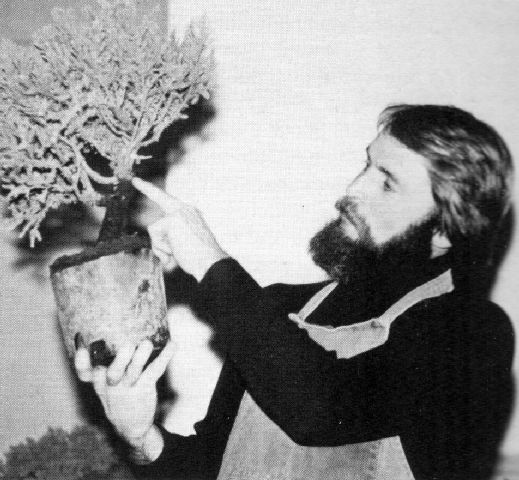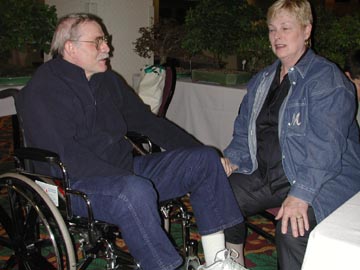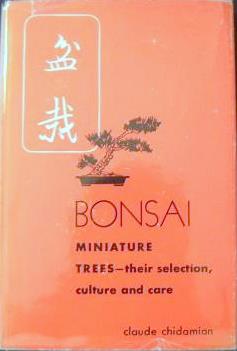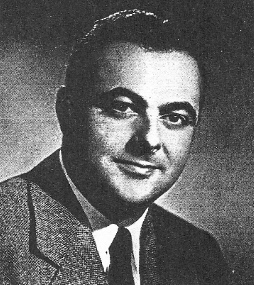| 11 |
2008 -- Vaughn Banting died this morning in Jefferson, LA, after a few days in hospice.
(Born in 1947, he founded The Greater New Orleans Bonsai Society
in 1972. He was a lecturer/demonstrator in the ABS Symposia of 1985, 1986, 1987, 1992, and 1996; the BCI
Conventions of 1983, 1985, and 1986; and the joint ABS-BCI-WBFF Convention of 1993. His specialty was the
bald cypress. He was a member of the National Bonsai Foundation. An inspired bonsai artist and teacher,
some details about his remarkable life can be found at
"Comprising a Life,"
http://web.archive.org/web/20120428122159/http://www.vlbanting.com/aboutme.htm and
"Profile: Vaughn Banting,"
http://artofbonsai.org/forum/viewtopic.php?p=8108.)
2008 -- The two-day 1st National Bonsai Exhibition opened today at the Monroe Community Hospital in Rochester, NY, spearheaded by William N. Valavanis. Bill wanted to celebrate the 30th Anniversary of International BONSAI since the world-wide bonsai community had been good to him and he just wanted to do a little something in return. The event presented to the world over 200 of the finest pre-judged masterpiece bonsai in the United States, representing the elevated, refined and accomplished level of bonsai in America. Both traditional and formal alcove displays allowed the true beauty of each bonsai to come alive with the effective use of accessory plantings, scrolls and other art. The event was supported by several organizations including the Nippon Bonsai Association, the World Bonsai Friendship Federation, Bonsai Clubs International, the National Bonsai Foundation, American Bonsai Society, Bonsai Societies of Florida, and others. Over 353 individual bonsai representing 144 individual artists were submitted for the selection process. Approximately 150 displays were then accepted. [When doors opened to the world on Saturday morning, there were 138 exhibits featuring 194 bonsai from 90 artists coming from 26 states and Puerto Rico. There were 14 shohin bonsai compositions with a total of 70 specimens. The three respected judges, Seiji Morimae, a Director of the Nippon Suiseki Association from Japan, Peter Warren from England and Pedro Morales from Puerto Rico, each would make detailed and written evaluation critiques for every displayed bonsai in order to provide their individual thoughts, comments and helpful suggestions for improvement. Over 40 people assisted in putting the exhibition together were all volunteers and Valavanis' dedicated students. The only paid staff was the professional photographer who came from North Carolina and Seiji Morimae's expenses from Japan. Everyone else was a volunteer, even Kathy Shaner and Suthin Sukosolvisit who would present continuing demonstrations during the exhibition. They would not charge, as the entire team wanted this event to succeed and it would with over 1600 manhours dedicated before the show opened -- in addition to all of Valavanis' time. Each of the exhibitors spent many days preparing their trees for this exhibition, not to mention the time, trouble and expense they had to attend. Seven West Coast exhibitors carefully loaded their trees on to David Kreutz's rental truck and sent their treasurers to Rochester, only to jump on a plane and arrive here to unload, exhibit and reload their trees. That's a LOT of work, as was the job of David Kreutz who drove 7,706 miles in the two weeks. (His time was not included in the above figures.) Dr. Alice W. Chen would also demonstrate Oriental brush painting during this exhibition. Some 1,143 people would enjoy seeing and studying the bonsai so distinctively displayed. Advertisements were put in six specialty magazines beginning over a year before the event and press releases were sent to the 50 largest papers throughout the country and to many bonsai organizations and clubs as well. The four TV channels in Rochester all came (one twice!) to film the set-up and final exhibition. They combined the set-up footage with an interview on Friday and ran the film all day on Saturday and Sunday. Congratulatory letters from the US Congress, New York State Senate, Japanese Consulate and a joint proclamation for "National Bonsai Exhibition Weekend" from the Mayor of Rochester and the Monroe County Executive. Yuji Yoshimura's two daughters from Tokyo and Boston also participated in the Ribbon Cutting Opening Ceremony together with other guests and judge Seiji Morimae from Japan. The Financial Times of London had also mentioned the First National Bonsai Exhibition in an article written on bonsai last April. Per a review in the Japanese bonsai magazine Kinbon 2009 Number 9, "The character of American bonsai is not inferior to Japanese (art) work." Following this show, the 2nd U.S. National Bonsai Exhibition would be announced for Father's Day Weekend, June 12-13, 2010, also in Rochester.] 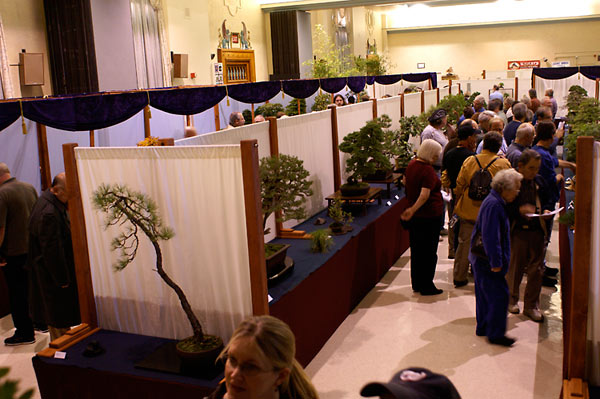
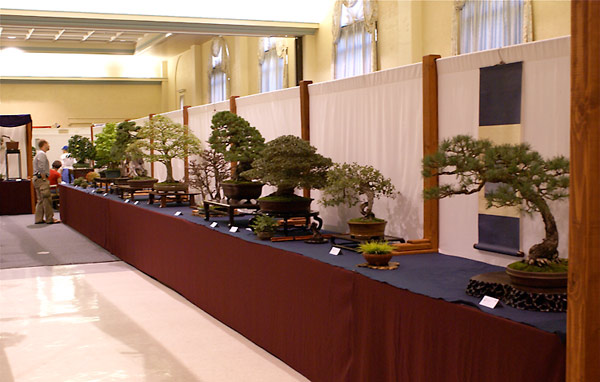
2011 -- Japanese Ambassador Ichiro Fujisaki conferred the Order of the Rising Sun, Gold Leaves with Rosette upon Dr. Thomas S. Elias at a formal ceremony and reception held at the ambassador's residence in Washington, D.C. Dr. Elias was presented with a certificate from the Emperor of Japan and a medal. This is the second most prestigious Japanese decoration which can be given to a non-Japanese. The award was given in recognition for his many years of significant contributions to the promotion of cultural exchange between Japan and the United States, and the introduction and development of Japanese culture. (Announced in November 2010, the ceremony was originally scheduled in the spring of 2011; however, all culturally-oriented events scheduled in that spring were cancelled or postponed following the March 11 magnitude 9.0 earthquake and tsunami off the northeast coast of Japan.) ("Tom Elias Awarded Order of the Rising Sun," Golden Statements, GSBF, Vol. XXXII, No. 1, January/February 2009, pg. 8.) SEE ALSO: Dec 30 |
||||
| 12 |
2019 -- A special autumn presentation (through November 24) started today in the Special Exhibition Room in the
Omiya Bonsai Museum in Saitama, Bonsai Beyond the Border: Yuji Yoshimura, a Bonsai Artist Across the Ocean; New
York, 1958. This commemorated the 10th anniversary of the Omiya Museum and the sister partnership with
the U.S. National Bonsai and Penjing Museum. Historical photographs, documents and other items illuminated
the lifetime work and passion of Yuji Yoshimura and his 37 year career in the United
States and abroad. His life's goal was to introduce the appreciation, artistry and practice of elegant
classical bonsai art. The Japanese bonsai community was now, 60 years later, recognizing the contributions
Yuji had made to expand the Japanese art of bonsai across the ocean. (In July 2019, Fumiya Taguchi, a curator at the Omiya Museum, had contacted RJB to see about getting a higher quality copy of the below photo of Yuji straddling the benches for use in this exhibit. The photo is in our Yoshimura biography, http://www.magiminiland.org/YY2.html, and was originally given to RJB by Alice Feffer, a founding member of the Phoenix Bonsai Society who apparently was gifted an autographed copy of the newspaper photo by Yuji. We were able to track down the copy in our archives and sent Mr. Taguchi a high-resolution scan. He chose this image because "it has very good composition and symbolizes the achievements of Mr. Yoshimura.") 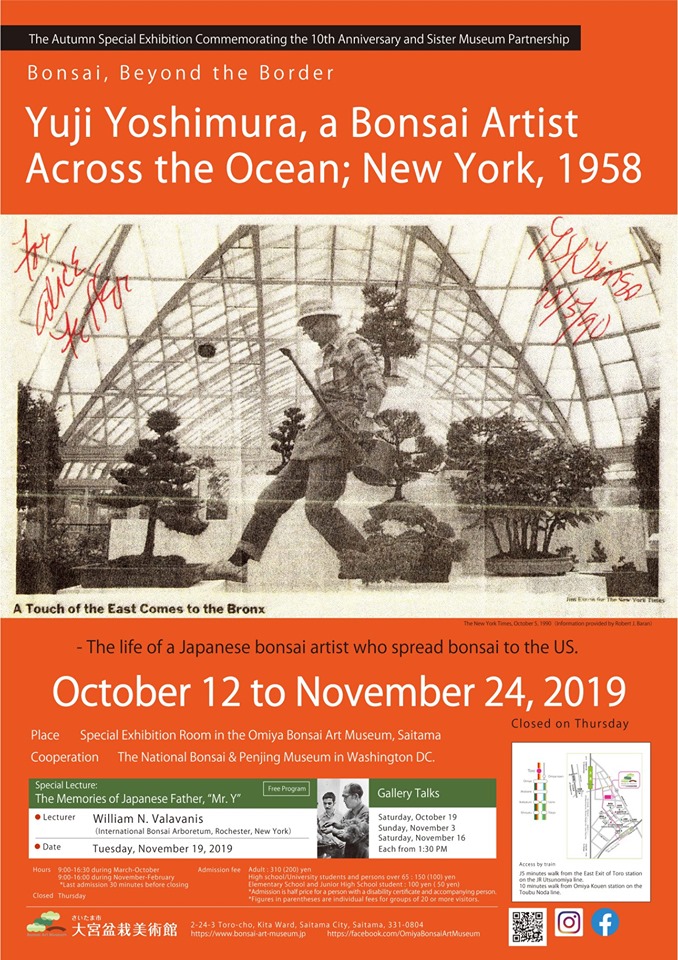
|
||||
| 13 |
1955 -- Claude Chidamian's book Bonsai: Miniature Trees was published today by D. Van Nostrand Company,
Inc. The ninety-six page work initially sold for $3.95 and included b&w photos and drawings by Shirlea
Hatcher, who illustrated other books of his. (Chidamian had been born in 1920, was editor (1948-49) of the
Southern California Camellia Society's The Camellia Review, and was an authority on ornamental
horticulture. He would be a regular contributor to the American Camellia Yearbook from at least
1947
through 1959. He had previously written Camellias and Common Sense (Richard Publishing; 1951.
He had married Lois
Ellfeldt, PhD. Physical Education, in Oct. 1954. Per pg. v of the Preface of Bonsai dated July
1955, Los Angeles, Claude had "twenty years of studying and growing bonsai.") [He would also write The
Book of Cacti and Other Succulents (The American Garden Guild and Doubleday; 1958) and Camellias for
Everyone (Doubleday; 1959).]
(Journal of the California Horticultural Society, pg. 37; Library Journal, pg. 534; Golden Gardens, pg. 20; The Camellia Review; AbeBooks.com; pg. 20; Contemporary Authors New Revision Series; A Primer for Choreographers; b&w photo from back inside jacket of Bonsai) 1978 -- The original bonsai exhibit opened today at the Morikami Museum and Japanese Gardens in Delray Beach, Florida. (The 200-acre Museum property had been donated to Palm Beach County by George Morikami in 1975. George was a Japanese immigrant who came to the U.S. in 1906 at the age of 19. He became a U.S. citizen in 1967. During all those years he farmed the land, first with a group of other Japanese immigrants and then by himself. The Museum opened June 25, 1977.) The Bonsai Societies of Florida started and maintained the exhibit, donating some of the trees. (The original bonsai were part of the Edward N. Potter Memorial Bonsai Colection. Donations from the public would make up the balance of the 75-plus trees, not one of which would have to be purchased by the Museum. The Morikami bonsai exhibit would be remodelled and reopened January 23, 2000, with a splendid new spacious location, the result of the development of five theme Japanese style gardens.) ["About the Morikami Museum and Japanese Gardens," NABF Newsletter #2, Feature #3, http://www.bonsai-wbff.org/nabf/newsletter2/flmorikami.htm ; "The Morikama" [sic], Bonsai Journal, ABS, Vol. 11, No. 4, Winter 1978, pg. 93] 2016 -- Frederick W. Boehringer passed away at Saginaw Senior Care in Saginaw, MI at the age of 102 years. A life-long florist in his family's business, he was a founding member of the San Toshi Bonsai Society (in Midland, MI about a dozen miles to the northwest). His wife, the former Doris Beyer preceded him in death in 1986. He is survived by 3 children, 7 grandchildren, and 13 great grandchildren. He was preceded in death by eight siblings. ("Frederick Boehringer Obituary," http://obits.mlive.com/obituaries/baycity/obituary.aspx?pid=181917888; Bloomfield, Ron Lost Bay City, Charleston, SC: Arcadia Publishing, 2015, pg. 55; "Doris Boehringer (1913-1986)," https://www.ancientfaces.com/person/doris-boehringer/53656396) SEE ALSO: Jul 14 |
||||
| 14 |
|
||||
| 15 |
1945 -- The Granada (aka Amache) Relocation Center officially closed, a month after the military police left.
(This Japanese-American internment camp was located in southeastern Colorado 140 miles east of Pueblo and 15 miles
west of the Kansas border. The center's common name was derived from the small town of
Granada, less than a mile away. The 10,500
acres of the camp reserve had been 18 privately owned farms and ranches, acquired by the WRA through purchase or
condemnation. Construction began June 12, 1942, with a crew of up to 1,000 hired workers and 50 evacuee
volunteers. The center was in operation by the end of August 1942, and reached the maximum population of
7,318 by October. Although Granada had the smallest population of the ten relocation centers, it was the
tenth largest city in Colorado when it was occupied. There were over 560 buildings, including a few
composed of sections of former Civilian
Conservation Corps buildings transported to the site. The entire developed area was surrounded by a
four-strand barbed wire fence, with six watch towers along the perimeter. The central or developed portion
of the camp was located on a low bluff overlooking the flood plain and farmlands, which extended to the north and
east all the way to the Arkansas River. Like most of the relocation centers, buildings and streets were
laid out on a north-south grid within an area about one mile square. Twenty-nine of the residential blocks
were used for housing; the buildings in one of the blocks were used for classrooms. Each block was laid out
according to standard plans, with 12 barracks each measuring 20 feet by 120 feet, a mess hall, a combination
laundry, bath, and latrine building, and a recreation building. Construction of the evacuee buildings at
Granada differed from the other relocation centers. Instead of post-and-pier foundations, barracks had slab
foundations, or concrete perimeter foundations with brick floors. The evacuee buildings also had fibre board
or asbestos shingle siding, rather than the tarpaper common at most of the other relocation centers. In
spite of its small population, Granada had one of the largest and most diversified agricultural enterprises of
the ten relocation centers. The farm program included the raising of vegetable crops, feed crops, beef and
dairy cattle, poultry, and hogs. Even the high school had a 500-acre farm, operated by vocational agriculture
students.) About 2,000 people from Amache remained in Colorado, which speaks well for the state. A
majority of the Japanese returned to California, their home. Why this is important to us: Held here in 1943 was probably the most extensive display of bon-kei seen to date in the Western world. A Mrs. Ninomiya and her two sons had arrived at the camp during an ongoing sand and dust storm. Those first days were so discouraging that she thought something must be done with this sand that was everywhere, inside and outside the barracks. She remembered one of the old home arts she had learned in Japan: the making of miniature dry landscapes, bon-kei. A neighbor built her a first tray from a vegetable crate; two or three close neighbors wanted to know how to make these pleasant employments in this new sparse environment. Word spread and in a short time there were ninety-two students, only one of which had ever done this before. This was a new and special incentive for most of the women who made these bon-kei: they now had [more than enough of] the time and opportunity to search for and express something beautiful out of the commonest and humblest thing around. Eagerness to do something worthwhile and willingness of those proficient to teach their neighbors resulted in the unforeseen high average ability of the evacuees to do these things well. Several exhibitions were the result of the creativity. Some of the tray gardens were of mountain, desert, and seacoast subjects, but most of them were imaginary Japanese scenes; and in no cases were there any duplicates. Fortunately, a few photographs were made. As time passed, the residents of the camps were able to get some of their belongings of this kind out of storage, and plant and flower containers were sent in as gifts, so in later photographs much greater variety is noticeable. (It is also worth mentioning that flower arrangement (ikebana="dancing flowers") was studied, taught, and practiced in every one of the ten War Relocation Centers. The construction of a few small traditional wet or dry gardens were documented outside of a few of the barracks. And one resident at the central Utah Topaz camp, a Mr. I. Ishii, who had left behind a perfect thirty-five year old maple bonsai he had raised, began experimenting with desert plants. When that camp closed, a greasewood shrub had been coaxed along by him for two years into a very attractive form. Its life after the war is unknown.) Please also see this list of photos from the Digital Public Library of America project of these compositions from various camps, many possibly grown by Moritaro Ishida at Manzanar: here, here, here, here, here, here, here, here, here, here, here, here, here, here, here, here, here (Granada), here (Heart Mountain), here (Heart Mountain), here (Heart Mountain), and here (Heart Mountain). 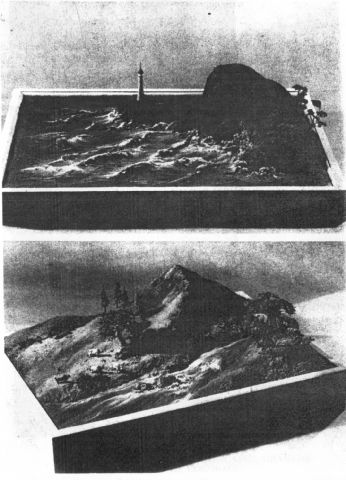
"Miniature Landscapes, Granada (Amache, Colorado)
(Chapter 5 "Granada Relocation Center" in Burton, J. and M. Farrell, F. Lord, and R. Lord
Confinement and Ethnicity: Barbed wire divider, An Overview of World War II Japanese American Relocation Sites,
http://www.cr.nps.gov/history/online_books/anthropology74/ce5.htm;
Amache Japanese Internment Camp, http://www.amache.org
; Eaton, Allen H.: Beauty Behind Barbed Wire, The Arts of the Japanese in Our War Relocation Camps
(New York: Harper & Brothers Publishers; 1952), pp. 16-19, 59, 88-90 ; see also
this
and
this
about two relocation camp-era trees, and the article "A Desert Survival Story" by Nancy Eaton,
Bonsai Magazine, BCI, Vol. XXII, No. 3, April 1983, pp. 79-80. It is not known if Nancy is related
to Allen. RJB's knowledge of this story would be incorpprated in the 2019 podcast
Bonsai
Behind Barbed Wire.)
The Art of Miniature Landscapes, bon-kei, Meaning Landscape on a Tray, Had Its First and Perhaps Its Best Development in Granada." (Photo by John D. Schiff, Fig. 7, pg. 17, in Eaton's book) 1993 -- A thirty-nine tree Stewartia monadelpha 'Grove' masterpiece forest which had been created by Saburō Katō at the World Bonsai Convention held in Orlando, Florida the previous May 29 was presented to the National Bonsai and Penjing Museum of the U.S. National Arboretum in Washington, D.C. Originating in Japan and being 9" to 39" tall, the trees had been planted with mosses and tiny wildflowers on a man-made American stone slab by the most renowned bonsai master and elder statesman. The composition was then put up for auction. It was purchased by the Board of Directors and Staff of Bonsai Clubs International, along with the contributions of a good number of friends. Also dedicated this same day were the George Yamaguchi North American Garden and the Haruo Kaneshiro Tropical Conservatory and Temperate Glasshouse. ("Dedication Day In U.S.A." by Jean C. Smith, Bonsai Magazine, BCI, Jan/Feb 1994, pp. 25-27; "Japanese Collection Gets A New Star" by Mary Bloomer, Bonsai Magazine, BCI, July/Aug 93, pg. 27) SEE ALSO: Jan 1, Jan 15, Apr 19, May 2, May 17, Nov 3 2008 -- Bonsai artist Marco Invernizzi made the front cover of this week's Japanese edition of Newsweek magazine. The featured article, "I Love Japan," contained interviews with 31 foreign specialists whose affinity for a particular discipline of Japanese culture further esteemed that nation's culture abroad. The specialists included a painter, a blogger, a ramen noodle shop owner, and the wife of a former Egyptian ambassador. ("Odds & Ends," Golden Statements, GSBF, Vol. XXXII, No. 1, January/February 2009, pg. 13.) SEE ALSO: Mar 31, Nov 7 |
||||
| 16 | 1949 - Christopher Monteith Cochrane was born in Virginia. [He would go on to become a prominent figure in the American suiseki world with long-time service in the National Bonsai Foundation.] ("OBITUARY Christopher Monteith Cochrane," Cremation Society of Virginia) SEE ALSO: Dec 23 | ||||
| 17 |
2008 -- "Bonsai," twenty postage stamps, were issued by the Philippines to
commemorate the 35th Anniversary three months earlier of the Philippine Bonsai Society, Inc.
SEE ALSO: Jan 29, Feb 3, Feb 16, Mar 1, Mar 27, Mar 31, Apr 3, Apr 6, Apr 18, May 6, May 29, Jun 16,
Jul 27, Aug 20, Aug 22, Sep 22, Oct 1, Oct 4, Dec 9.
2015 -- The Clark Bonsai Collection was officially established with a two-day grand opening celebration. It is a partnership dedicated to the preservation and advancement of bonsai in the Central Valley of California. The collection is a living art display with about 140 museum quality bonsai, offering stunning rotating seasonal displays, with docent tours available. Only around 25 are on display at any given time, with rotation done every 90 days bringing in other trees from the storage area. Each tree has been designed by bonsai artists throughout the state over the past 75 years. The intimate Central Collection joins the larger North Collection at Oakland's Lake Merritt and the Southern Collection at San Marino's Huntington Garden. The Collection exhibit area was designed by local landscape architect, Bob Boro, with construction led by design-build contractor, Sid Mukai. The display space reflects the characteristics of a Japanese stroll garden with a hide-and-reveal design providing new vistas at every turn. Water conservation was the overriding focus of the landscape design and the irrigation system for the bonsai throughout the collection. The double redundant mirrowed water system was designed and built by Ray Thieme and Gene Nelson from the Fresno Bonsai Society. (The collection began with the commitment and dedication of Willard "Bill" Clark, founder of the Clark Center for Japanese Art and Culture, and Bob Hilvers, a local bonsai artist who became the collection's curator in 2000. This resulted in the establishment of one of the finest public bonsai collections in North America. It includes a Legacy Collection created by many of the early pioneers of bonsai in California before, during and after WWII. It is unique in that it strives to preserve these bonsai as they were created by the original artists. This provides a unique opportunity for generations of bonsai enthusiasts to understand their cultural and historical contributions to the art of bonsai in California. (For more than 20 years, the Clark Center in Hanford has provided a small but world-class museum experience in the central San Joaquin Valley. That era came to an end June 30, 2015. As announced in 2013, the Clark Center closed its doors. Founders Bill and Elizabeth "Libby" Clark gave the center's entire collection to the Minneapolis Institute of Arts (MIA). The Clarks subsidized the center, and they didn't want to pass that burden along to their children. Plus, they were concerned about the expense of preserving the often fragile artworks. Nearly 1,700 objects spanning a period of 10 centuries, with an estimated value of $25 million, went to MIA. Along with the center's collection, the Clarks offered their private collection in an arrangement that was part gift and part purchase. When the donation was announced in 2013, the plan was for the Hanford center to be open for five years with rotating shows curated by the Minneapolis museum. But in 2014 a firm closing date of June 30 was announced, cutting that five-year grace period short by three years. (In 2014, a year ahead of their closure, the Clark Center for Asian Arts and Culture gifted their legacy Bonsai Collection to the Golden State Bonsai Federation (GSBF). GSBF responded to the Shinzen Friendship Garden's robust campaign to present Fresno as the preferred site with its decision to house this world-class Collection there within a specially created bonsai exhibit area. Incorporated and dedicated in 1981, the Garden is a traditional northwestern American Japanese Garden located in Woodward Park, Fresno, CA. It was constructed to honor Fresno's Sister City, Kōchi, Japan, celebrating the spirit of understanding and promoting educational and cultural awareness.) [In July 2016, Richard Brustlin would generously donate forty beautiful old bonsai to the Golden State Bonsai Federation and those trees (and several high quality bonsai pots) would be entrusted to the Clark Bonsai Collection. Several of the trees would represent the best of American Bonsai Art including a rare Monterey Pine (Pinus radiata), considered by some experts to be the finest in existence. Here is a recent article about the collection. Some 35,000 visitors would be expected in 2021.] ("The Clark Bonsai Collection," https://web.archive.org/web/20160614140938/https://www.shinzenjapanesegarden.org/clark-bonsai.html; "GSBF CLARK BONSAI COLLECTION AT THE SHINZEN FRIENDSHIP GARDEN," The Dai Ichi Gazette, May 2016, Vol. 31, Issue 5, pp. 11, 13; George, Carmen "Find your own 'Zen moment' with bountiful bonsai in Fresno's Shinzen Friendship Garden," The Fresno Bee, March 9, 2016, https://web.archive.org/web/20160410205045/https://www.fresnobee.com/living/article64602297.html; "Shinzen Friendship Garden, http://www.shinzenjapanesegarden.org/; Munroe, Donald "Last days for Hanford's Clark Center for Japanese Art and Culture," The Fresno Bee, June 24, 2015, http://www.fresnobee.com/entertainment/performing-arts/article25413823.html; Clark Bonsai Collection at Shinzen Facebook posting, July 28, 2016; "Clark Bonsai Collection Curator Bob Hilvers talks to ABAS," American Bonsai Association Sacramento, 1 Jun 2021) SEE ALSO: Mar Also, Apr 6 |
||||
| 18 |
|
||||
| 19 | 1996 -- The first Carolina Bonsai Expo began its two-day run at the North Carolina Arboretum in Asheville, NC. [After that first year the event would be moved to the second weekend of each October. The Expo would feature displays provided by bonsai organizations from a 6-state region consisting of NC, SC, TN, VA, GA and PA. By 2009 thirteen clubs would be participating. In addition to the show of trees, the Expo would include workshops, lecture/demonstrations, critiques and a bonsai marketplace. The Expo would attract between 3,000 and 3,500 visitors each year. Guest artists for the event would include: Dan Chiplis ('96); Peter Adams ('97 and '08); Susumu Nakamura ('98); David DeGroot ('99); Chase and Solita Rosade ('00); Walter Pall and Jim Doyle ('01); Harry Tomlinson ('02); Rodney Clemons ('03); Qingquan Zhao ('04); Dan Robinson ('05); William Valavanis ('06); Brussel Martin ('07); and Kathy Shaner ('09). The full list can be found here.] (Personal e-mail to RJB from Arthur Joura, 28 Jan 2010) SEE ALSO: Oct 8 | ||||
| 20 |
1967 -- Shigeru Yoshida died. (He had been born in 1878 in Tokyo as the fifth
son of the civil rights activist Tsuna Takenouchi of Tosa. His mother was rumored to be a geisha.
He was sent to live with the childless Yokohama industrialist Kenzo Yoshida and his wife, who later adopted him
and provided him with a good education and a sizeable inheritance. After attending the elite
Tokyo Imperial University, Yoshida married into
a prominent family. He lived the first thirty-five years of his life in the reign of the
Emperor Meiji and had many of the characteristics
attributed to the leaders of that era, such as education in the Chinese classics, patriotic pride, loyalty to the
throne, and, in many cases, a broad international outlook. He entered Japan's diplomatic corps in 1906 just
after Japan's victory against Russia in the Russo-Japanese
War. His career included posts in China and Italy before he became Ambassador to England in 1936.
In London he developed considerable admiration for the British political system, with its parliamentary politics
and combination of aristocratic and democratic traditions. Barely five feet tall and chubby, he possessed a
sharp wit and willingness to express strong personal opinions which set him apart from most Japanese, particularly
other bureaucrats. In fact, his public life seemed to be over when he retired in 1939, having fallen out of
favor with the government for his anti-militarism; he was also imprisoned late in the war for the same
reason. But on the very day
General Douglas MacArthur
established his headquarters at the Dai Ichi Building in Tokyo, Yoshida was summoned to the capital to join the
new Japanese cabinet as foreign minister. He would serve ably in that capacity until called to be prime
minister in the spring of 1946. Along with his quaint but very understandable English, such attitudes made
Yoshida a natural choice to deal with the Americans after the war. From
May 22, 1946 - May 24, 1947 (45th), and then
Oct. 15, 1948 through Dec. 10, 1954 (48th-51st), he served 2,616 days as prime minister. On Sept 7, 1951 he
spoke at the
San Francisco Peace Conference where he was
a signatory to the Peace Treaty and the Security Treaty between Japan and the U.S. He retired from the Diet
of Japan in 1955. By setting the course for Japan in these crucial postwar years, Yoshida became one of the
fathers of modern Japan: his Democratic-Liberal successors would dominate Japanese politics into the 1990s.
He made a great contribution to laying a foundation for the Japan's postwar reconstruction and worked to cultivate
Japan's future statesmen.)
Why this is important to us: Because of a rapid increase in the number of bonsai enthusiasts in Japan in the early 1960s, the necessity to transform the Kokufu Bonsai Society into a nationwide organization became obvious. In 1965, the private Kokufu was dissolved and reorganized to become the parent body of the public Nippon Bonsai Association. The NBA's first president was... Shigeru Yoshida. For the last two and a half years of his life he thus ably served in that office. <Photos of him at the 40th Kokufuten in 1966 can be found by clicking on the "Celebrities" button of the Kyukaen website.> [He would be followed in the NBA presidency by another former Prime Minister (from Feb. 1957 - July 1960), Nobusuke Kishi, and in 1988, Takeo Fukuda, also a former Prime Minister (from Dec. 1976 - Dec. 1978), would become the third President of the Nippon Bonsai Association.] 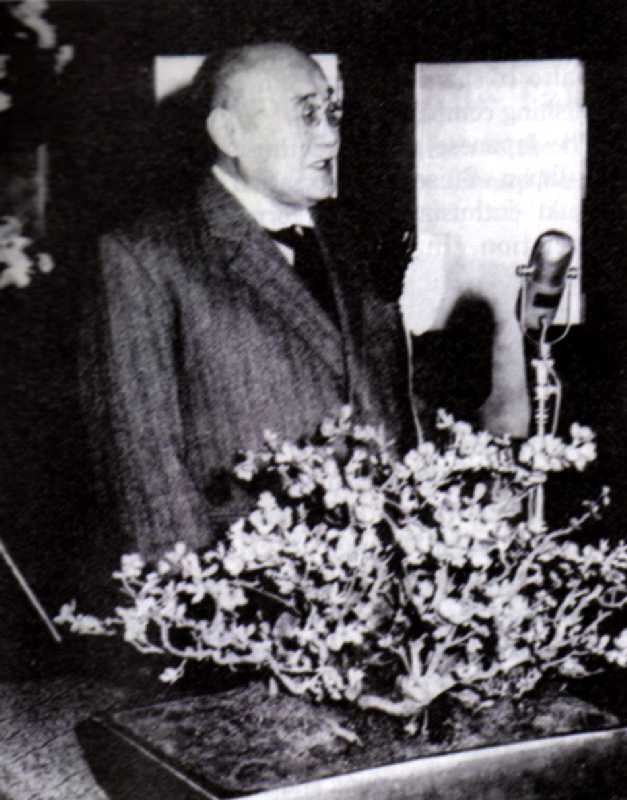
"The first NBA President Shigeru Yoshida gives a speech
during the inauguration of Nippon Bonsai Association in 1965." ("Shigeru Yoshida," http://www.kantei.go.jp/foreign/cabinet/45_e.html ; "Prime Minister Yoshida Shigeru (1878-1967)," http://www.pbs.org/wgbh/amex/macarthur/peopleevents/pandeAMEX110.html ; "Historical Figures," http://www.ndl.go.jp/constitution/e/etc/figures.html ; "Shigeru Yoshida," http://en.wikipedia.org/wiki/Shigeru_Yoshida#As_Prime_Minister ; Morita, Kazuya and NBA Editorial Staff "Bonsai in Japan," in Tsukiyama, Ted T. (ed.) Bonsai of the World, Book I (Japan: World Bonsai Friendship Federation, 1993), pg. 89, including photo.) SEE ALSO: Sep 22 2021 -- Robert F. "Bob" Drechsler died at age 88. Bob had been the first curator of the U.S. National Bonsai & Penjing collection, 1975-1998, and then volunteered there until 2015. SEE ALSO: Feb Also, Apr 1, Apr 9, Apr 22. |
